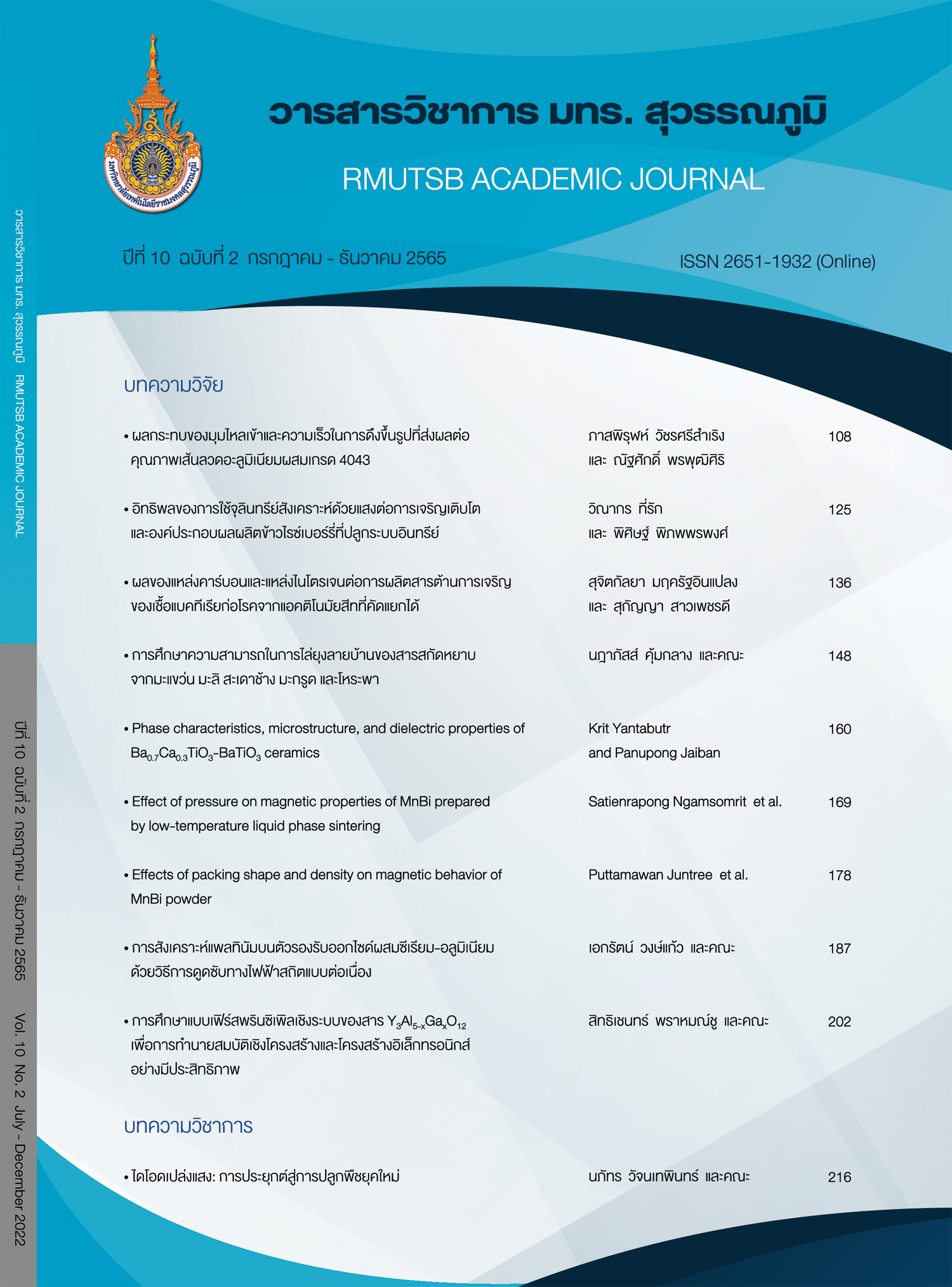Effects of photosynthetic bacteria on growth and yield components of riceberry rice cultivated in organic systems
Main Article Content
Abstract
This work aimed to study on effects of photosynthetic bacteria, as a replacement for chemical fertilizers, on growth, yield, and yield components of riceberry rice cultivated in organic systems. A completely randomized design experiment with 400 pots was conducted. The 100 pots were used for each cultivation method with four 25-pot repetitions. The first cultivation method used chemical fertilizers (control), the second, third and fourth cultivation methods used photosynthetic bacterial suspensions with a volume of 5, 10, and 15 milliliters, respectively. The results showed that there was no statistically significant difference in rice growth after 30 and 50 days, plant height, and tillering (p>0.05). After 50 days, leaf greenness (SPAD index) of the rice cultivated with the chemical fertilizers was the highest. The greenness of the rice grown with 10 and 15 ml of photosynthetic bacteria was not statistically different from the rice grown with the chemical fertilizers, while the greenness of the rice grown with 5 ml of photosynthetic bacteria was statistically different (p<0.05) from the control. In terms of yield, the rice grown with the chemical fertilizers and 15 ml of the photosynthetic bacteria had the highest number of rice panicles per tiller, and the chemically cultivated rice had the highest number of seeds per panicle. There was no statistically significant difference (p>0.05) in percentages of fertile seed among the four cultivation methods. Yield components i.e., 100 seed weight, seed length and width, and 100 brown seed weight, of the four sample groups were not statistically different (p>0.05). In conclusion, the photosynthetic bacteria with a volume of 15 ml can be used as a substitute for chemical fertilizers for rice cultivation in pots. However, using the photosynthetic bacteria to replace chemical fertilizers in rice field plots requires further investigation.
Article Details

This work is licensed under a Creative Commons Attribution-NonCommercial-NoDerivatives 4.0 International License.
Published manuscript are the rights of their original owners and RMUTSB Academic Journal. The manuscript content belongs to the authors' idea, it is not the opinion of the journal's committee and not the responsibility of Rajamangala University of Technology Suvarnabhumi
References
Chuenmathunpaijit, C., Malumpong, C., Thongjoo, C., Chutteang, C., & Romkaew, J. (2021). Effect of high temperature at reproductive stage on seed set, yield and yield components of rice. RMUTSB Academic Journal, 9(1), 1-13. (in Thai)
Fuengchan, S. (1995). Nutrients for horticulture. Khonkaen: Siriphan offset printing. (in Thai)
Kaenjampa, P., & Tengjaroenkul, B. (2017). Photosynthetic bacteria. Khon Kaen University Journal, 2(4), 1-15. (in Thai)
Khush, G. (1997). Origin, dispersal, cultivation and variation of rice. Plant Molecular Biology, 35, 25-34.
Land Development Department. (2012). Thailand soil and land resources situation. Bangkok: Ministry of Agriculture and Cooperatives. (in Thai)
Rice Department. (2019). Rice knowledge bank. Retrieved 26 September 2019, from http:// www. ricethailand. go.th/ rkb3/15%E0%B8%81%E0%B8%8243.pdf (in Thai)
Thairath. (2017). Preparedness of organic livestock for the national strategy. Retrieved 23 February 2019, from https://www.thairath.co.th/content/115813 (in Thai)
Theerak, W., Sumranram, W., & Chanchula, N. (2022). Suitability study of indigenous rice varieties for promoting cultivation in Pathum Thani Province. RMUTSB Academic Journal, 10(1), 89-97. (in Thai)
Theerak, W., Sumranram, W., & Rattanakaew, T. (2020). Effects of photosynthetic bacteria and bio extract on growth and yield of RD43 rice cultivated in organic systems. Journal of Agricultural Research and Extension, 37(2), 25-35. (in Thai)


